There was a "planned" and "surreptitious attack" to put idols inside the Babri masjid at Ayodhya on the intervening night of December 22-23, 1949 and some officials connived with Hindus and refused to remove them, Muslim parties said in the Supreme Court on Tuesday.

A 5-judge Constitution bench headed by Chief Justice Ranjan Gogoi, hearing the Ram Janambhoomi-Babri Masjid land dispute on 18th day, was told by senior advocate Rajeev Dhavan representing Muslim parties that the then deputy commissioner of Faizabad K K Nayar did not allow removal of idols despite a specific direction.
"The appearance of idols of deities inside Babri was not a miracle. It was a planned and surreptitious attack to put them on the intervening night of December 22-23, 1949," Dhavan told the bench, also comprising justices S A Bobde, D Y Chandrachud, Ashok Bhushan and S A Nazeer.
The lawyer, representing Sunni Waqf Board and one of the original litigants, M Siddiq, claimed that he knew the "inside story" and said that Nayar later contested Lok Sabha polls as a candidate of Bharatiya Jan Sangh.
On December 16, 1949, Nair sent a letter to the chief secretary of the state stating that a grand temple constructed by Vikramaditya was existing there before that was demolished by Babur in 1528, Dhavan said, adding, "This was Mr. Nayar's contribution".
He referred to photographs of internal parts of disputed site cited by Hindu parties and alleged that government officers including Nayar had violated the order to maintain 'status quo' at the site, which was attached on January 5, 1950 following the placing of idols inside, by allowing capturing of pictures.
"They (pictures) had no effects on the merits of the case," the bench observed.
"Of course, they have. Because, they have been used to say that treat it like a temple," Dhavan said, adding that the photographs allegedly contained sketches of Gods, Goddess, lotus and peacock and have been used by Hindus.
Dhavan said Hindus did not allow Muslims to pray and then said Muslims never offered 'namaz' since 1934.
"They say that the law of limitation and the doctrine of adverse possession will run against you, because we did not allow you to possess and worship," he said, countering the submissions that Muslims were not in possession and never offered prayers regularly.
"As a matter of fact, was there any action taken by Muslims," the bench asked.
Dhavan said that Muslims had complained to Wakf inspector about it.
The keys of the site were with the Muslim side and they could not enter to offer prayer because it was locked after the attachment in 1950 and police did not let them in and they were scared.
The bench then asked as to whether the witness, who had alleged that Muslims were not allowed inside, was cross-examined. "We are only on the veracity of the statement of the witness".
Documents showed Muslims had been offering prayers on Fridays in the inner courtyard, Dhavan said and referred to sequence of events to highlight that Hindus planned to install idols and the local administration did not act despite the fact that there was a report in March, 1949 to this effect that something untoward may happen.
He referred to Jerusalem and said that it can be argued that two religious places were existing, but contending that there was no mosque would amount to telling a lie.
Dhavan extensively dealt with the alleged contradictions in the pleadings in two lawsuit filed by Hindu parties, Nirmohi Akahara and deity Ram Lalla.
He said 'Akahara' opposes the lawsuits of the deity and alleged that the case filed by "Ram Lalla' was "malacious" and the deity can only file the lawsuit through the shebait (devotee).
Dealing with the submission of 'Swaymbhu', he said that if the court accepts this then the entire land, due to the faith and spirit of the Hindu devotees, would assume the character of the divine and Muslims will be out of the suit property and as per Hindus "the janmsthan itself becomes the deity".
He said 'parikrama' is one of the forms of worshipping and it can be used to claim entitlement over the property.
The bench said the deity and the 'Janmsthan' the (birth place) have been made separate parties just to delineate the 'birthplace of the Lord Ram.
The bench asked Dhavan whether the claim of deity over the land, besides the central dome, rests on the 'Swaymbhu' arguments only.
It asked can the deity, which has been granted central dome as its birth place, can claim ownership over other places inside the site as there were 'Ram Chabutra and Sita Rasoi' also.
He said that Akhara was "impatient" and has filed the case to seek management and shebait right only and they are not seeking title of the property.
Akahara has made government officials as parties in its lawsuit filed 1959 and has alleged that Muslims conspired to get its property attached in 1950.
Muslims support the lawsuit of Akahara to the extent that it opposes the case of the deity, he said, adding that Akahara had alleged that the idols, which were put on 'Ram Chabutara' in outer courtyard, were shifted to inner courtyard and Muslims support it.
Dhavan would continue his arguments on Wednesday.
The Allahabad high court, in its judgment of 2010 on four civil lawsuits, had partitioned the 2.77-acre disputed land equally among the three parties -- Sunni Waqf Board, Nirmohi Akhara and Ram Lalla.
Fourteen appeals have been filed in the Supreme Court against the verdict.
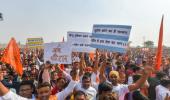
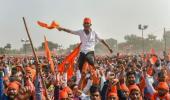
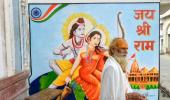
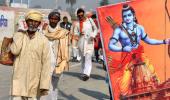




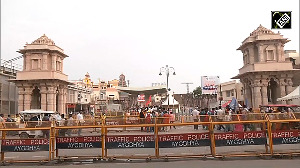
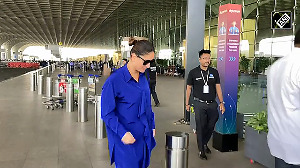

 © 2025
© 2025